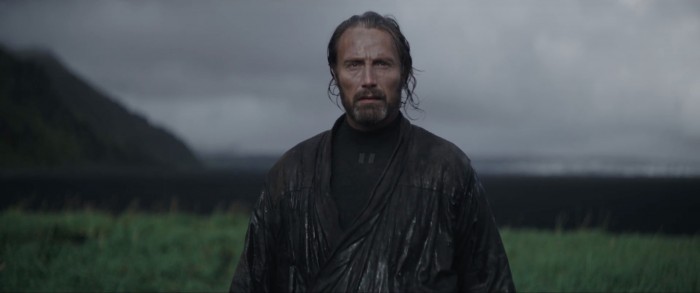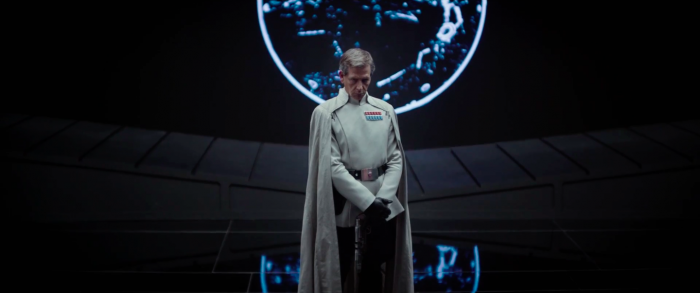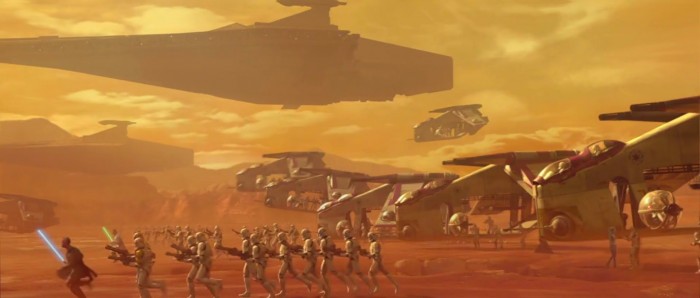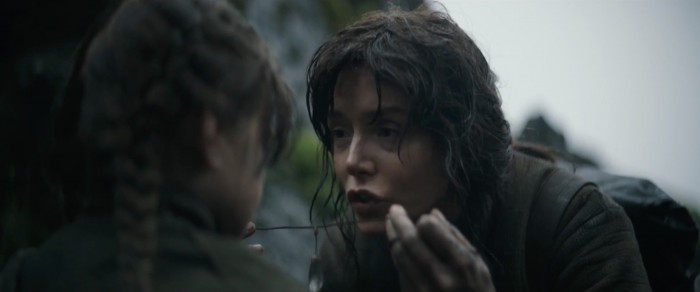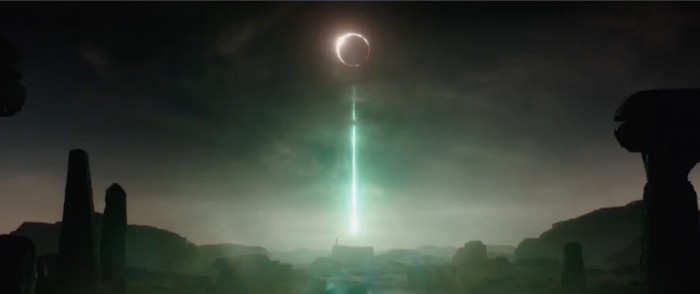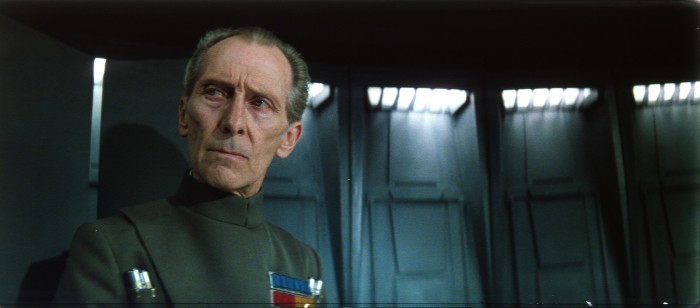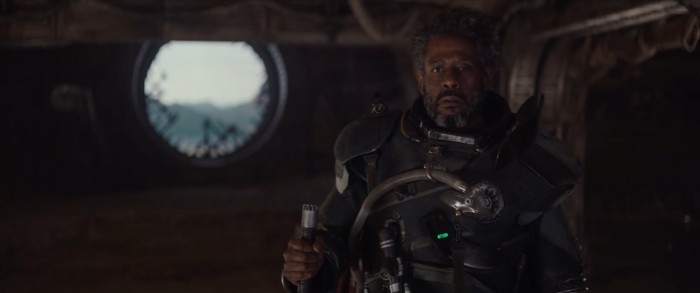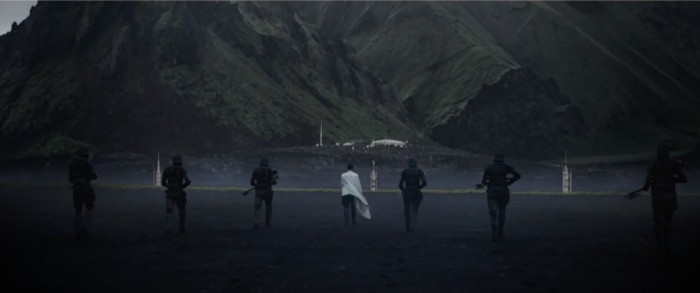'Catalyst: A Rogue One Novel': Everything You Need To Know About The New 'Star Wars' Book
James Luceno's new novel Catalyst: A Rogue One Novel has to fill a very specific gap in the Star Wars timeline – it's a prequel to a prequel, while also being a sequel to the prequel trilogy.
Specifically, it explores the backstory of key characters from Rogue One: A Star Wars Story, following them as they survive the Clone Wars and the rule of the newly formed Galactic Empire. Even more specifically, it tells the stories of Galen Erso, a genius scientist manipulated into helping build the Death Star, and Orson Krennic, the vicious Imperial commander in charge of building the new moon-sized super-weapon.
If you plan to read Catalyst, this article is not for you. It's a pretty good book, albeit in a "for dedicated Star Wars fans only" kind of way. It's brisk. It's fun. It's full of little details that will please and intrigue the already initiated. But if you're a more casual fan, the kind of person who wants to know the backstory of various Rogue One characters before you see the movie but don't want to actually read a Star Wars novel, we've got you covered. Here's everything you need to know about Catalyst.
The Strategic Advisory Cell
Catalyst begins with the Clone Wars in full swing, roughly a year after the events of Star Wars: Episode II – Attack of the Clones. While the Jedi are frequently mentioned and characters like Chancellor Palpatine and Count Dooku play important roles in the background, none of them actually appear in the book, with the action driven entirely by those working directly on the Republic's top secret battle station project.
The weapon that will eventually become know as the Death Star is initially cooked up in a committee that hides behind an innocuous title: the Strategic Advisory Cell, a group of 150 influential politicians, scientists, and military commanders who meet in secret on the capital planet of Coruscant with one goal – complete the construction of this mammoth super-weapon before Count Dooku and his Separatist forces can complete one of their own. Catalyst never delves into what followers of Star Wars already know: there is no second battle station and Count Dooku and Palpatine are secretly on the same side.
It's at a meeting of the Strategic Advisory Cell that we first meet Lt. Commander Orson Krennic, the ambitious former engineer in charge of the actual building of the battle station and it's here that he realizes there is only one man who can actually create a weapon powerful enough to make it a true military threat: Galen Erso.
Galen Erso
Before he was a (slightly eccentric) genius scientist with a specialization in using crystals to create energy, Galen Erso (played by Mads Mikkelsen in the Rogue One film) was a child prodigy born on the backwater planet of Grange. His parents supported his innate intelligence and desire to learn and he was eventually accepted into the Republic's Futures Program, where he honed his skills, befriended a fellow student named Orson Krennic, and fell in love with a woman named Lyra.
When Catalyst begins, Galen is working for the Zerpen corporation on the planet Vallt, using crystals to generate energy with the longterm goal of low-cost, renewable energy for the entire galaxy. And while he knows there's a war on, he's a pacifist and a conscientious objector. Galen has chosen to remain neutral, even as the Clone Wars reach Vallt and he's captured, alongside a very pregnant Lyra, and taken prisoner by Separatist forces.
After many months in prison, the Erso family is rescued as part of a daring Republic operation led by Lt. Commander Orson Krennic, who has a message for his old school chum. Before taking Galen back to Coruscant, he swings by his home planet of Grange, which is the site of an ongoing battle between Republic and Separatist forces. Horrified by seeing his home world in flames, Galen begins to doubt his neutrality, putting him on a very dark path... and walking him right into the hands of his so-called friend, Krennic.
Orson Krennic
Before he was the secret coordinator of the Special Weapons Group and personally overseeing the construction of the battle station that will one day be the Death Star, Orson Krennic (played by Ben Mendelsohn in Rogue One) was a member of the Republic's Corps of Engineers. But overseeing the construction and renovation of buildings throughout Coruscant was not enough for this ambitious young man – he sees himself as destined for great things and will lie, cheat, and manipulate to get through any door, change any mind, and coerce any victim to do his bidding. Unlike the shy, soft-spoken Galen Erso, Krennic is a man about town and a natural socialite, capable of working a room like a natural politician. He never directly injures and kills anyone during the events of Catalyst, but far too many people are harmed thanks to his machinations. His words, and his basic lack of empathy, are as powerful as a legion of Stormtroopers.
Naturally, Krennic arranges the rescue of Galen, Lyra, and the newborn Jyn not because he wants to assist an old friend, but because he knows his old school mate is the only person in the galaxy who can build a weapon worthy of the time, money, and energy being put into his battle station's construction. But Krennic is a smart guy and knows that Galen would never agree to join the project if asked – he'll have to make the decision himself. Thus the rescue attempt, which immediately puts Galen in Krennic's debt. Thus the trip to Grange, to show Galen that his own people were suffering. That's only the beginning, though, as Krennic quietly has Galen accused of espionage and encourages the Zerpen corporation to not rehire their lost scientist, putting pressure on his family and deliberately limiting his options. After taking a job far below his talents and barely surviving a Separatist attack, Galen finds himself officially trapped in Krennic's web, ready to join his old buddy on "Project Celestial Power," entirely unaware that his old friend has maneuvered him to this place and that his groundbreaking energy research is being weaponized in a different facility.
The Geonosis Connection
We know from the Rogue One trailers that key components of the Death Star are built on the Imperial Construction Yards on the paradise planet of Scarif. But the actual shell of battle station is constructed in the orbit of Geonosis, the desolate desert plant where the Clone Wars actually began (see: the final 45 minutes of Attack of the Clones). This is where James Luceno has to work with (and around) material that is directly depicted in the prequel trilogy, as that film depicts a Geonosian leader showing off plans for the Death Star to Count Dooku.
So here's the quick version. The Geonosians, a bug-like race who view life as meaningless and kill each other at the drop of a hat, are master builders, having constructed the bulk of the Separatists' droid army in their factories. They also designed a powerful battle station, but those plans were captured by the Republic, who decide that he only way to keep the Separatists from building this monstrosity is to build their own. Naturally, this was Palpatine's plan all along, not that anyone in Catalyst ever actually realizes this.
So portions of Catalyst take place in and around Geonosis, with Orson Krennic dealing with worker disputes (i.e., the Geonosian drones murdering each other by the thousands on the job) and treachery from the planet's archduke, who is let out of prison under the condition that he serve the Republic and ends up ordering his people to sabotage the project. It's no wonder that the Death Star isn't even close to being done when the book is over – building it over Geonosis turns out to be a massive inconvenience.
Kyber Crystals
When we first meet Galen on Vallt, he's conducting his energy research using synthesized kyber crystals supplied by the Zerpen corporation. Real kyber crystals are hard to come by, as the Jedi Order uses them to power their lightsabers and adorn their temples, claiming that they harness the Force and should be used only be used by those who understand them. Naturally, the pragmatic Galen sees this as a silly roadblock to his research (although his more spiritual wife has a difference of opinion).
About halfway through Catalyst, the Clone Wars come to an end, the Empire is created, Palpatine initiates Order 66, and Jedi Knights across the galaxy are wiped out in the blink of an eye. Suddenly, Galen has access to all of the kyber crystals he needs, from the tiny versions found in the hilts of lightsabers to the boulder-sized crystals taken from temples. Galen, who is now working from a research facility built specifically for his work on Corsucant, is able to overlook the fact that that he's working with the tools of men and women executed by the Empire. Lyra, not so much.
Eventually, Galen has a breakthrough and learns how a kyber crystal can tap into "untamable" power. The only issue, he tells Krennic, is containment. Of course, Krennic is less concerned about that since he wants to unleash that power, not use it power homes and cities. Without Galen's knowledge, Krennic has a separate team replicate his research elsewhere, building a prototype weapon.
While Catalyst doesn't dwell on it too much, it is heavily suggested that Galen's attempt to science his way into these mystical crystals taps into the Dark Side of the Force. This means the destructive energy of the kyber crystal, the Death Star superlaser that can blow up an entire planet, is literally powered by evil.
Lyra Erso
While Galen spends the bulk of Catalyst immersed in his research and failing to notice that he's being manipulated, his wife, Lyra, gets to act as his conscience. Despite her background as a scientist and geographical surveyor, she has a spiritual side and believes that "only the Force is perfect," deriving great pleasure from exploring and experiencing the natural world. Like her husband, she tends to avoid conflict. Unlike her husband, she has a nose for bullshit and doesn't trust Krennic much from the moment they meet.
Lyra's role in the story is fairly obvious at times – she has to yank Galen out of the fire, expose him to the conspiracy he's been pulled into, and convince him that his research is being weaponized. However, she plays a more subtle role that actually has a massive effect on the entire Star Wars saga. While surveying a planet for kyber crystals (actually part of a plot by Krennic to pull her away from Galen), she befriends a Dressellian pilot named Has Obitt and helps him learn to connect with the Force. In the short term, he supplies her with vital information about Krennic's plans. In the long term...we'll get there.
How Do you Build a Death Star?
If you want to construct a battle station the size and shape of a small moon, you're going need a lot of raw materials. Since the Empire is young and still solidifying its grip in the galaxy, Krennic and his allies need an excuse to plunder innocent planets for their natural resources. Enter Has Obitt, a pilot and smuggler on Krennic's payroll who has been coerced and duped into his fair share of horrible, galaxy-scarring situations in the name of progress!
It's a fairly simple con job: Has picks up a bunch of confiscated Separatist weapons from an Imperial storage depot, transports them to a planet rich in materials necessary to build the Death Star, and the Empire invades the planet because they've been "buying" illegal goods, overthrowing the local government and strip-mining the planet until it's a barren wasteland. Long before it was blowing up planets, the Death Star was destroying entire worlds.
And this is before you get to one of Krennic's early attempts to weaponize Galen's energy research, which resulted in the complete destruction of a facility... and the death of tens of thousands of citizens in a neighboring city.
The Normalization of the Empire
But why aren't the citizens of the former Republic not crying out over the destruction of these worlds, many of them "Legacy" planets that were supposed to remain untouched by law? It's simple, really: no one cares. The media isn't reporting it. The citizens of the core worlds don't pay attention to what's happening at the fringes of the galaxy. When Orson Krennic is confronted by a lawyer representing one of the planets being torn apart for its resources, he literally shrugs her off. No one is going to get their day in court.
It's startling how quickly the galaxy settles into being ruled by an Empire. Everyone is shocked at first, but the wars are over and people aren't dying anymore and things don't seem that bad. Why not give Emperor Palpatine a chance? It's made explicitly clear that the Empire is at its weakest in its earliest days and that a concerted resistance could topple it. Instead, everyone waits and sees, allowing more planets to fall under its sway. I'm reminded of one of the highlights of the prequel trilogy: Padme, watching Palpatine give himself total control, says "So this is how liberty dies, with thunderous applause."
This is best explored through Galen himself, who rationalizes his new supply of kyber crystals by assuring himself that the Jedi were traitors (because the Emperor said so) and that they deserved to be wiped out and that he might as well make use of what they left behind. The Jedi doomed themselves, he says. And now, he's working to achieve "Palpatine's dream" of infinitely renewable energy! None of the Empire's decisions have personally affected him yet, so he has no reason to be alarmed. Of course, Galen eventually does need help and finds that his list of allies, of people who can stand up the Empire, has dwindled to almost no one.
And if you're wondering why the Jedi seem like an ancient myth in the original Star Wars despite being active just decades earlier, Catalyst explains: "In what seems merely standard weeks to Lyra, the Order all but passed into myth, with scarcely a trace or mourning or grief. Orson's new age had dawned and the Jedi were relegated to history." When things are changing so quickly, it's easy to not realize that your situation is not normal.
Wilhuff Tarkin
One character from the original Star Wars trilogy plays a major role in Catalyst. Wilhuff Tarkin (played by Peter Cushing in the original 1977 film) is a high-ranking Imperial intelligence officer and one of the first men to achieve the Emperor's new rank of "Moff." He also has his eye on Orson Krennic's top secret weapons project and intends to take it off his hands when the opportunity arises. As Tarkin sees it, Krennic can spend years getting dragged through the mud, absorbing every hardship involved in making the battle station happen, allowing him to swoop in and take over when he's at his weakest.
The rivalry between Tarkin and Krennic is actually the most entertaining part of Catalyst, feeling like a Game of Thrones subplot implanted into the Star Wars universe. Both men see the long game, trying to think two moves ahead of their opponent, sacrificing thousands of lives and entire planets to land a proper blow. Of course, we all know how this ends: Tarkin is in command of the Death Star during the events of the original Star Wars film. It takes 30 years, but he gets what he wants. It's a short-lived victory, but at least you may understand why he's so dead-set on remaining on board the Death Star during the Rebel attack – this is destiny.
The Earliest Days of the Rebellion
One of Orson Krennic's most extreme chess moves against Tarkin involves using the growing conscience of Has Obitt against him. Realizing that his chief weapon in framing planets to extract their resources is having second thoughts about the whole endeavor after meeting Lyra Erso, he decides to kill two birds with one stone. He gives Has a new assignment, to deliver weapons to the planet Salient II, knowing that the smuggler won't go through with the assignment and will choose to warn the system instead.
So when Tarkin shows up with his Star Destroyer to confiscate the illegal weapon and claim the planet in the name of the Empire, he finds himself facing immediate resistance from both the Salient military and a ragtag group of smugglers and mercenaries assembles by Has Obitt himself. Suddenly, Tarkin has a war to fight and can't concern himself with whatever Krennic is up to.
Among those ready to fight to protect Salient II is a veteran of the Clone Wars named Saw Gerrera, a soldier who sees the Empire for what it is and plans to fight (Saw originally debuted in the Star Wars: The Clone Wars animated series and an older version of this character is played by Forest Whitaker in Rogue One). This group manages to keep Tarkin's forces at bay for some time, but their resistance eventually crumbles, with Has being captured and Saw escaping.
While this group is ultimately crushed by Tarkin and while the whole resistance effort was a side effect of Krennic needing to tie up his rival with a conflict to keep him out of his hair, the defense of Salient II is noteworthy for being the seed that will eventually sprout into the Rebel alliance. This is the first time anyone stood up the Empire and at least one man present (Saw Gerrera) will continue to fight them for decades. When you pause and think about it, the two people responsible for the Rebel Alliance are Orson Krennic, whose sneaky plan to keep Tarkin occupied will really blow up in his face in the long run, and Lyra Erso, whose acts of kindness toward her smuggler pilot gave him the conscience to stand up against his superiors.
A New Home... and Jyn Erso
In the end, Galen gets some sense knocked into him by Lyra, realizes that he's being manipulated by Orson Krennic, and decides to flee Coruscant with his family. Galen refuses to destroy his research, hoping that leaving it behind will give the Empire less incentive to hunt them down (although they won't be able to actually finish the Death Star's main weapon without him). He's wrong, of course. Catalyst ends with Krennic receiving a demotion for letting the Ersos escape, ending his rise to power and humiliating him. He vows to track down Galen at all costs.
We know from the Rogue One trailers that he eventually finds them and things go to hell for the Erso family in a big way. But Catalyst ends on a happy note, with Saw Gerrera rescuing the Ersos from Coruscant and taking them to a distant and unspoiled planet called Lah'mu, where they can live in peace and hide from the Empire. Saw promises to visit, giving Galen a comm card that will put them in instant communication should the need ever arise.
The book ends with young Jyn, only a few years old and blissfully unaware of everything that has happened, looking forward to building a new home with her mother and father. Her hopes will soon be dashed. But we'll have to wait until Rogue One is in theaters to see how older Jyn (played by Felicity Jones) deals with her father's legacy while battling the old "family friend" that ruined their lives decades earlier.

